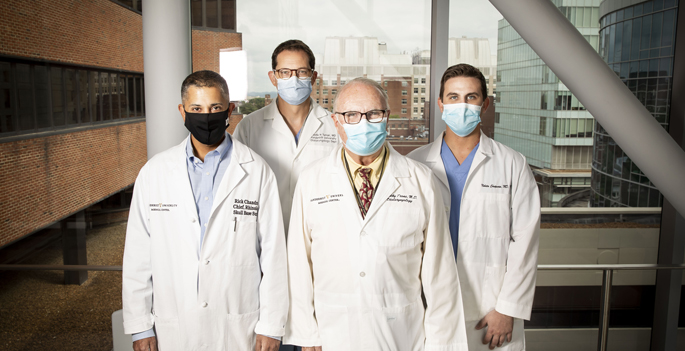
Smell and taste loss (hyposmia) was one of the first recognized symptoms that indicated a person may have COVID-19. Eighteen months later, hyposmia is still a prominent symptom of the disease, with many patients not regaining full use of their senses for weeks or even months after recovering from infection.
“Smell and taste dysfunction is incredibly common with COVID-19 infection,” said Justin Turner, MD, PhD, associate professor of Otolaryngology-Head and Neck Surgery and medical director of VUMC’s Smell and Taste Loss Center. “In fact, almost all patients will have some smell loss when assessed using objective measures. That leaves potentially millions of post-COVID-19 patients with persistent smell loss, and we don’t yet fully understand why these patients do not recover,” Turner said.
“One out of two patients that contract COVID-19 develop a significant alteration in smell and taste, usually within the first five days,” added Timothy Trone, MD, assistant professor of Otolaryngology. “Fortunately, 95% of those individuals recover over eight to 10 weeks. Women, especially younger women, seem to be more impaired than men.”
To better evaluate and predict who is at risk of persistent smell and taste loss after COVID-19 infection, Rakesh Chandra, MD, professor of Otolaryngology and chief of Rhinology and Skull Base Surgery, and Nikita Chapurin, MD, MHS, Otolaryngology resident, conducted a large population study of 1,003 patients with confirmed COVID-19 positivity to learn more about the prevalence, time course and factors associated with this symptom. Their findings were reported in the International Forum of Allergy and Rhinology.
“VUMC is home to one of only two smell and taste clinics in the entire country. This has become an extremely important topic during the COVID pandemic, and VUMC Otolaryngology is on the very forefront of predicting and improving the impact on patients,” said Eben Rosenthal, MD, incoming chair of Otolaryngology-Head and Neck Surgery.
Of the patients studied, 73% reported some degree of smell and taste loss or dysfunction, with the average case of hyposmia lasting 19.7 days. Interestingly, researchers found that patients who reported more severe hyposmia earlier on in their infection tended to deal with smell and taste loss for a much longer duration than patients who reported hyposmia later in their infection.
Statistically significant predictors for patients reporting moderate to severe hyposmia included male gender, sore throat, gastrointestinal symptoms, prior taste disturbances and absence of fever. Additionally, body mass index and shortness of breath were significantly associated with prolonged duration of hyposmia.
Patient age, female gender, history of chronic rhinosinusitis, diabetes, hypertension, asthma, fewer days from COVID-19 diagnosis to clinic evaluation and higher body mass index were all statistically significant predictors of higher total SNOT-22 scores. SNOT-22 is a validated 22-item sino-nasal outcomes test which assesses a range of symptoms related to quality of life in patients with chronic rhinosinusitis. The patient rates each of 22 symptoms from zero (absent) to five (as severe as it can be). The questionnaire has also been applied to examine outcomes in other nasal and sinus disorders.
Chandra and Chapurin suggest that total SNOT-22 scores correlate with many COVID-19 symptoms, including prevalence and duration of hyposmia.
They believe the SNOT-22 instrument may be useful in measuring and following post-COVID-19 rhinologic symptoms and smell and taste dysfunction.
Overall, 13.4% of patients studied reported a prolonged duration of smell and taste loss for more than four weeks, and 10.7% of patients reported persistent hyposmia longer than six weeks. These findings provide further evidence that a substantial number of COVID-19 patients have prolonged or persistent hyposmia — an important factor to consider when counseling patients on long-term recovery expectations.
“There’s a certain amount of COVID-19 fatigue in medicine and society,” Chapurin said. “But COVID is here to stay. About 200 million people have been affected by it, and even if only 10% have prolonged hyposmia recovery, that’s a significant number of patients with a reduced quality of life. We hope clinicians can use this data and other data coming out around the country to give patients a more accurate expectation of recovery.”
Chandra and Chapurin are now focusing their efforts on researching the rate of permanent hyposmia after COVID-19 infection. They plan to do this by re-surveying these 1,003 patients.
“We are going to need to start treating these long-term issues,” Chandra said. “Even with normal seasonal colds, 0.5% of people have a permanent effect on their senses. The number for COVID is bound to be higher than that. We think it’s going to affect a whole generation of people.”












